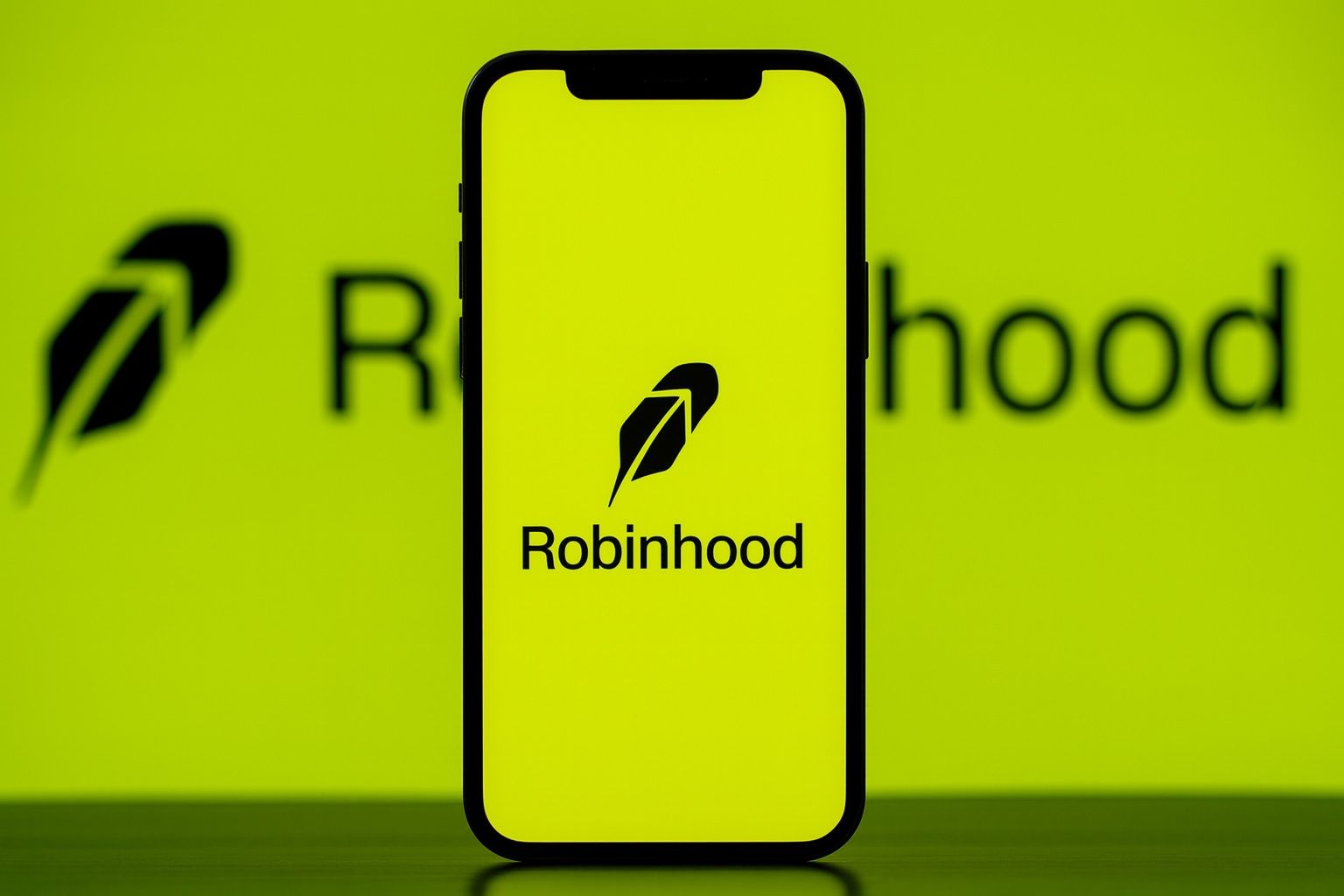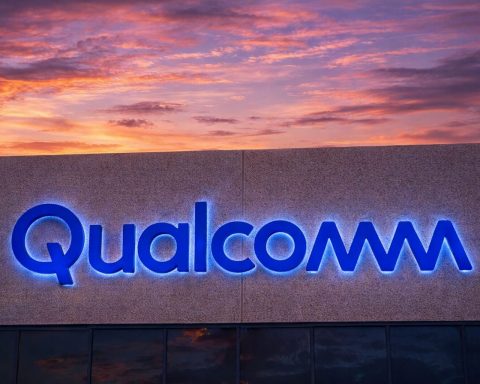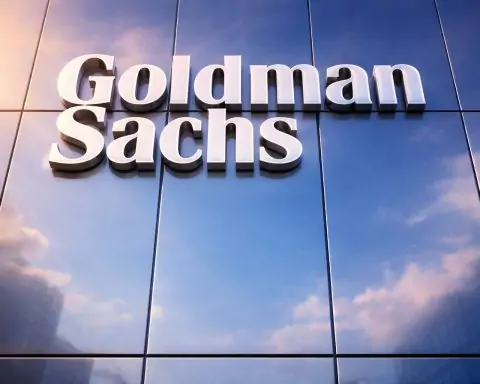Key Facts (as of Oct. 20, 2025):
- Stock Price & Momentum: Robinhood Markets (NASDAQ: HOOD) stock trades around $130 per share today, cooling from all-time highs near $153 earlier this month [1]. Shares slipped about 1% Friday and ~8% last week amid market volatility, but remain up ~250% year-to-date – making HOOD one of 2025’s top-performing S&P 500 stocks [2] [3].
- Massive 2025 Surge: The stock surged over +200% in 2025 on the back of booming earnings and new product launches [4]. Robinhood’s late-September addition to the S&P 500 index (after its market cap topped $100 billion) further fueled demand, with index funds snapping up shares [5]. It’s now a $120+ billion fintech giant, and even after the recent pullback, HOOD has vastly outpaced the broader market this year [6].
- New Products & Crypto Push: Robinhood has aggressively expanded its offerings. It rolled out event contracts (“prediction markets”) in the U.S., letting users bet on outcomes from elections to sports – a fast-growing segment now generating an estimated $200+ million annual revenue run-rate [7]. In Europe, the company quietly added nearly 500 tokenized U.S. stocks and ETFs on a blockchain network, enabling 24/7 trading under EU regulations [8] [9]. It also introduced micro futures for Bitcoin, XRP, and Solana [10], and is rolling out “Robinhood Banking” accounts (Gold members get 4.0% APY savings, FDIC-insured) to deepen its fintech super-app ambitions [11].
- Financials – Profits Soar: The company’s earnings have exploded in 2025. Q2 revenue jumped 45% year-over-year to $989 million, with net income more than doubling to $386 million (EPS $0.42 vs ~$0.30 expected) [12]. User growth and engagement hit records – funded accounts reached ~26½ million and paid Gold subscribers surged 76% to 3.5 million [13] – driving a ~50% profit margin. Q3 results are due Oct. 29, and Wall Street expects another strong quarter (~$1.14 billion revenue, ~$0.45 EPS) [14].
- Analyst Sentiment: Wall Street is bullish but cautious. Consensus rating: “Moderate Buy,” with about 12 Buys vs 6–7 Holds [15]. Major banks recently hiked their price targets (e.g. Mizuho $145, Goldman $152, BofA $157) [16], and Piper Sandler just boosted its target from $140 to $155 [17]. However, the average 12-month target sits ~$118–$120 [18] – below the current price – reflecting valuation concerns. At ~62× earnings (double the S&P 500’s P/E), some analysts warn HOOD’s rich valuation may limit further upside [19].
- Big News & Catalysts: Robinhood signaled it’s eyeing acquisitions to grow its prediction markets business, as interest in event trading “surges globally,” according to a top executive [20]. The platform also suffered an unusual outage on Oct. 6 that briefly halted trades [21], coinciding with a rival’s launch (Galaxy Digital’s new “GalaxyOne” trading app) targeting Robinhood’s users [22]. Broader market swings – like U.S.–China tariff scares – have fueled volatility (HOOD plunged 8.9% in one day on Oct. 10) [23]. Looking ahead, upcoming earnings, Fed rate decisions, and new product rollouts (like expanded crypto features) could be pivotal for the stock’s next moves.
HOOD Stock on a Tear – and a Tumble
Robinhood’s 2025 stock trajectory has been nothing short of meteoric – with a few wild swings along the way. The trading app’s shares have nearly tripled in 2025, vaulting from the low $30s in January to recent highs in the $150s [24]. In late September, Robinhood joined the S&P 500, marking a “watershed moment” for fintech and instantly boosting its profile (index funds tracking the S&P had to buy in) [25] [26]. By early October, HOOD hit an all-time high around $153 per share [27] – a stunning ~+250% year-to-date gain that made it 2025’s top-performing S&P stock [28].
However, this red-hot rally has come with crypto-like volatility. On October 10, HOOD suddenly plunged ~9% in a single session [29] amid a broader tech selloff. The catalyst: macro jitters, as rumors of steep U.S. tariffs on China spooked markets. (One strategist noted we’ve “seen this movie before” with trade-war scares – and indeed, the White House quickly walked back the tariff threats, calming investors [30].) Robinhood’s stock stabilized around the mid-$130s after that tumble. Last week, it drifted lower again – closing Friday at about $129.91, roughly 15% off its peak – as some traders took profits ahead of major tech earnings and a looming Fed meeting. Even so, HOOD is still up ~249% in 2025 [31] and boasts a market capitalization north of $120 billion [32], an almost unheard-of ascent for a company that went public just four years ago.
This massive run-up reflects both Robinhood’s strong fundamentals and a resurgence of retail trading mania. The company’s commission-free model famously revolutionized investing for Millennials and Gen Z, and retail traders now account for an estimated 10–20% of U.S. stock volume [33]. That retail fervor – from meme stocks to crypto – is back in force in 2025, and Robinhood has ridden the wave. Its S&P 500 inclusion even suggests a degree of mainstream validation that was hard to imagine during the meme-stock frenzy of 2021 [34]. “Robinhood’s rise is a validation of fintech’s rise” one analyst said, noting that the company has evolved from its volatile beginnings into a major player held by institutional investors [35]. Still, skeptics note that waves eventually crest. After a 1,200%+ share price jump in three years [36], valuation risks are creeping in – a point we’ll return to when examining analyst views.
Financial Firepower: Earnings Are Booming
Behind Robinhood’s rally is a dramatic financial turnaround. The company, which struggled with losses in its early post-IPO days, has now strung together multiple profitable quarters. In Q2 2025, revenue exploded +45% year-over-year to $989 million, handily beating forecasts, while net income doubled to $386 million [37]. Earnings per share came in at $0.42, crushing the ~$0.30 consensus estimate [38]. Robinhood’s transaction-based revenues saw especially strong growth – options trading revenue jumped 65% YoY, crypto trading revenue hit $160M, and even stock trading revenue rose despite zero commissions [39]. Higher interest income (from uninvested cash and margin loans) also boosted results, though management noted that declining interest rates could temper that tailwind going forward [40].
Crucially, Robinhood’s user base and engagement are at record highs, driving its top-line growth. Funded accounts reached about 26.5 million in Q2 (up 10% year-on-year) and users are trading more actively [41]. The company’s premium Robinhood Gold subscriptions – which offer higher instant deposits, research, and now 4% interest on cash – have surged to 3.5 million paid members [42]. Thanks to increased monetization (more trading activity + interest on larger cash balances), average revenue per user jumped ~34% YoY [43]. All this has supercharged profitability: Robinhood posted roughly 50% net profit margins last quarter [44], an almost unheard-of figure in the brokerage industry. Over the last 12 months it earned ~$1.8 billion profit on ~$3.6B revenue [45], signaling a highly scalable model.
With such momentum, expectations are high for Q3 2025 earnings, due in just over a week. Analysts predict revenue around $1.13–$1.15 billion and EPS of ~$0.45 [46], implying ~40%+ growth vs. a year ago. Notably, Q3 will include the first full quarter of revenue from Robinhood’s recently acquired crypto exchange (Bitstamp) and its expanded event contract trading, which could provide an extra boost. Management has emphasized “profitable growth” and disciplined cost control as priorities [47] – a strategy clearly paying off, as the company has now firmly transitioned from hyper-growth mode to a high-growth, high-margin business. If Robinhood can meet or beat the aggressive Q3 forecasts, it may reinforce the bull case that the platform’s new initiatives are unlocking fresh revenue streams. Conversely, any stumble or cautious outlook (especially around user growth or margins) could give investors pause, given the stock’s lofty valuation.
From Trading App to “Financial Super-App” – New Features Galore
Robinhood isn’t content to just rest on its laurels – 2025 has seen a blitz of new product launches and expansion moves, as the company aims to transform from a stock trading app into a comprehensive fintech platform. CEO Vlad Tenev has described a vision of Robinhood as a global “financial super-app” offering everything from equities and crypto to savings accounts and sports betting markets [48]. Recent developments underscore this push:
- Event Contracts (Prediction Markets): In March, Robinhood rolled out a dedicated event trading hub in the U.S., partnering with Kalshi (a CFTC-regulated exchange) to let users wager on “yes/no” questions about real-world events [49]. These prediction markets – which surged in popularity around the 2024 election – allow trading on outcomes like Fed interest rate moves, economic data, or even sports championships [50]. The feature has taken off: by September, Piper Sandler estimated Robinhood’s event contract volume was already annualizing over $200 million in revenue [51], with Robinhood users making up 25–35% of Kalshi’s daily volume [52]. Seeing the opportunity, Robinhood is now “open to acquisitions” to grow this business, said JB Mackenzie, an executive overseeing the product [53]. “If there’s [a deal] of interest, we’ll pursue it,” he told Reuters, while noting Robinhood will balance buying with building in-house [54]. With the 2024 U.S. elections and major sports events on the horizon, demand for event contracts is expected to stay strong – and Robinhood signaled it might even consider joint ventures or partnerships to expand in this once-niche market [55] [56].
- Crypto & Tokenized Stocks: Robinhood has doubled down on its crypto offerings and innovative assets. Just days ago, the company expanded its tokenization initiative in Europe, quietly deploying 80 new tokenized stocks on the Arbitrum blockchain and bringing the total to nearly 500 tokenized U.S. stocks and ETFs available to EU customers [57]. These are blockchain-based stock tokens (derivatives tracking real share prices under EU’s MiFID II rules) that allow 24/7 fractional trading with as little as €1 [58]. It’s an ambitious effort to tap global demand – though it’s drawn regulator attention (Lithuania’s central bank is reviewing the structure) [59]. In addition, Robinhood recently launched micro futures for Bitcoin, XRP, and Solana – small-sized crypto futures contracts aimed at retail traders [60]. The company’s crypto unit has been expanding via M&A as well: in May, Robinhood acquired Canadian crypto platform WonderFi for $179 million to extend its international footprint [61]. And earlier this year it completed the $200M purchase of Bitstamp, a major European crypto exchange, which is now integrated to offer deeper liquidity and global crypto trading to Robinhood users [62]. All told, Robinhood is aggressively positioning itself as a go-to crypto brokerage alongside Coinbase – even as it urges regulators in the U.S. to clarify rules around tokenized securities (Robinhood filed a proposal with the SEC advocating a unified framework for “real-world asset” tokens) [63].
- Traditional Trading Enhancements: Robinhood hasn’t forgotten its core equity traders either. Last month, the company held its HOOD Summit 2025 event, unveiling a suite of advanced tools for power users. New features include a social trading feed (“Robinhood Social”), AI-powered stock screeners and indicators, and more sophisticated charting for the growing ranks of active traders on the platform. These upgrades follow the late-2024 launch of “Robinhood Legend,” a full-featured desktop trading platform catering to experienced users with customizable layouts and pro-level analytics [64] [65]. “We’ve matured alongside our customers… they want more advanced products and tools,” Robinhood’s Chief Brokerage Officer Steve Quirk said at that launch [66]. The firm also began offering futures and index options trading in its app (Gold subscribers can trade futures for as low as $0.50/contract – undercutting industry fee standards) [67]. By expanding into areas traditionally dominated by big brokers and banks – futures, options, research – Robinhood aims to keep its newly affluent user base from “graduating” to other platforms.
- Banking & Savings Products: In a strategic move beyond trading, Robinhood is rolling out banking features to become more of a full-service financial hub. This fall it introduced “Robinhood Banking” accounts with a high-yield twist: customers on the Gold plan earn 4.0% APY on savings (with FDIC insurance via partner banks) and get perks like no-fee cash withdrawals and even VIP event access [68]. The accounts, now in early access, come with a debit card and are designed to lock in customer loyalty – especially higher-balance clients who might otherwise drift to traditional banks or fintech rivals. “It’s about meeting all of customers’ needs,” Tenev has said, framing banking as a logical next step for Robinhood [69] [70]. The company already offers IRAs with matching contributions and is reportedly exploring more retirement and wealth products. By deepening its ecosystem (spanning trading, savings, lending, and investing), Robinhood is aiming to increase the lifetime value of its 20+ million users and make itself the primary financial app for a new generation.
This flurry of innovation underscores Robinhood’s evolution from an upstart trading app into a diversified fintech player. It also puts the company in direct competition with both Wall Street incumbents and crypto-native firms. Robinhood’s commission-free stock trading forced the likes of Schwab and Fidelity to eliminate stock commissions years ago [71]; now its push into crypto and tokenized assets challenges exchanges like Coinbase, and its move into banking and credit encroaches on turf of neobanks (Chime, SoFi) and even traditional banks. The upside: a much broader addressable market and more ways to monetize its user base. The risk: execution and compliance – each new product brings operational complexity and regulatory scrutiny, areas where Robinhood has hit stumbling blocks before.
What Wall Street Is Saying: Bullish, But Eyes on Valuation
Despite Robinhood’s strong growth, analysts are split on just how much upside is left in the stock after its massive run. The consensus rating sits between Buy and Hold – effectively a cautious “Moderate Buy.” According to MarketBeat, about 12 analysts rate HOOD a Buy, 7 say Hold, and 1 recommends Sell [72]. Price targets diverge widely. Many analysts concede Robinhood’s fundamentals have dramatically improved, but some worry the stock is priced for perfection after rocketing +200–300% in a year.
On the bullish end, a flurry of upgrades and target hikes came in as HOOD surged into the S&P 500. For instance, Bank of America lifted its target to $157; Mizuho to $145; Goldman Sachs to $152; Morgan Stanley to $146 – all higher than their previous forecasts [73]. Just last week (Oct. 14), Piper Sandler raised its target from $140 to $155 and reiterated an Overweight rating [74], citing Robinhood’s accelerating revenue streams and the popularity of its new products despite recent market “geopolitical tensions.” And notably, JMP Securities (Citizens) is even more bullish – it reportedly issued a Street-high $170 target in early October [75], implying significant upside if Robinhood’s growth narrative plays out. Optimists argue that Robinhood is not the same company it was in 2021–2022 – it’s now profitable, scaling, and expanding into multiple verticals. One Mizuho analyst lauded Robinhood’s “product enhancements” as “step-function improvements that will attract more users and boost engagement” [76], suggesting the platform’s innovations (social features, advanced tools, new asset classes) can drive sustained growth. Bulls also point to the still-untapped potential of Robinhood’s huge user base – if the company can cross-sell more products (crypto wallets, credit cards, savings, etc.) to even a fraction of its tens of millions of users, revenue could climb faster than traditional brokerages’.
That said, plenty of voices urge caution. The average 12-month price target is around $118–$120 [77], below the current trading price, indicating many analysts see the stock as fully valued or even mildly overvalued for now. Robinhood’s valuation multiples have ballooned: at ~$130/share, it trades near 65× trailing earnings and ~20× sales – exceedingly rich for a brokerage/business with cyclical elements. By comparison, Charles Schwab trades around 15× earnings. As a result, some firms are advising clients to wait for dips. Citigroup, for example, upgraded Robinhood from Sell recently but only to Neutral, declaring the stock “fairly valued” around ~$135 [78]. Zacks Investment Research likewise noted HOOD’s high P/E and warned that any slowdown in growth or hiccup in execution could spur a pullback. In short, the skeptics aren’t bearish on Robinhood’s business; rather, they question the stock’s momentum relative to fundamentals. They note that much of 2025’s earnings boom has come from unusually favorable conditions (surging trading volumes, high interest rates boosting net interest income, etc.) that may not be as strong going forward.
There’s also the matter of regulatory and reputational risk, which lingers in the background. Robinhood has had run-ins with regulators in the past (from the SEC’s now-closed probe of its crypto unit to FINRA fines over outages). In early 2025, it paid $45 million to settle SEC charges over various compliance lapses [79]. While these issues seem under control – and regulators appear to be providing clearer crypto guidelines, easing some uncertainty [80] – any new snafu could sour investor sentiment quickly. Additionally, competition is heating up: not only are fintech upstarts launching copycat trading apps (as Galaxy Digital did [81]), but established brokers like Fidelity are rolling out crypto trading and zero-fee features to defend their turf. If Robinhood’s user growth were to stall as a result, those lofty growth expectations baked into the share price would have to be reevaluated.
For now, most analysts are keeping a positive tilt: roughly 70% of ratings are Buys, reflecting confidence in Robinhood’s trajectory [82]. But there’s a clear message that the stock’s next phase will require proof of sustained execution. As one strategist put it, “the company’s doing great, but the stock has come a long way – maybe too far, too fast.” The upcoming Q3 earnings call will be closely watched for guidance on 2026, any hints of a slowdown in trading activity, or margin pressures as the company invests in new offerings.
Outlook: Can Robinhood Keep Defying Gravity?
Going forward, Robinhood faces the challenge of meeting sky-high expectations. The stock’s incredible year-to-date performance reflects both robust current results and optimism for the future – perhaps a bit too much optimism, in the view of some. To keep climbing from here, Robinhood will need to deliver flawless execution and capitalize on its new ventures:
- Near-Term Catalysts: The most immediate catalyst is Q3 earnings on Oct. 29. A big beat (or miss) could easily swing the volatile stock. Also on the horizon is the Federal Reserve’s late-October meeting – a likely rate cut is expected [83] [84]. Lower interest rates are a double-edged sword for Robinhood: they can spur stock market activity (good for trading revenue) but also reduce net interest income the platform earns on customer cash. How Robinhood navigates a potential Fed easing cycle will be important. Additionally, any updates on user growth (did the fall’s high-profile outages or competition slow new signups?) and on upcoming product launches – e.g. a rumored U.K. re-entry or further international expansion – will set the tone. Macro wildcards like trade war news or economic data could also continue to whipsaw high-beta stocks like HOOD in the coming weeks, independent of fundamentals.
- Sustaining Growth into 2026: Looking further out, Robinhood’s mission is to expand beyond trading and monetize its large user base across many financial needs. The groundwork laid in 2025 (event markets, tokenized assets, banking services, international expansion) is promising, but execution will be key. If even a couple of these initiatives hit stride – say, Robinhood becomes a leader in retail event betting, or grabs meaningful share in Europe’s crypto trading via Bitstamp and tokenized stocks – it could unlock new revenue streams to justify the stock’s valuation. The company’s own forecast (from prior communications) is to keep growing revenues ~30-40% annually while maintaining strong profitability. Achieving that will likely require continued user growth (both adding new customers and re-activating lapsed ones) and increasing average revenue per user, all while fending off competitors.
- Analyst Forecasts: For now, consensus projects FY2025 EPS around $1.90 and 2026 around $2.30 (according to TipRanks) [85] – implying a forward P/E still in the high-50s. Bulls argue these estimates could prove low if Robinhood’s new products gain traction faster than expected. Bears counter that a normalization of trading activity (e.g. if the meme/crypto frenzy cools) could make those estimates too high. Price target-wise, as noted, the Street median is ~$120, suggesting modest downside or consolidation. Yet the more optimistic forecasts (>$150) show some see further upside if Robinhood continues to surprise to the upside on earnings. We may also see more M&A play a role – Robinhood could use its hefty stock as currency to acquire niche players (for instance, in prediction markets or overseas) to accelerate growth, which investors might cheer if done strategically.
In sum, Robinhood’s story in 2025 has been one of remarkable growth and growing pains. The company finds itself at the forefront of multiple booming trends – retail trading, crypto, fintech “super-app” services – and has so far executed impressively, as evidenced by its financial results and stock performance. This has earned Robinhood a place among the market’s elite, but also a valuation that assumes it will keep up the pace. As we head into late 2025, the big question is whether Robinhood can maintain its breakneck momentum. The pieces are in place: a massive and engaged user base, diversified revenue streams, and a finger on the pulse of what new-gen investors want. If management delivers and external conditions remain favorable, some experts say the stock could continue its climb – one analyst even quipped that Robinhood could become the “Amazon of personal finance” in the long run, given its ecosystem ambitions. On the other hand, any stumble or cooling of enthusiasm could prompt a reality check for its valuation.
For investors and market watchers, Robinhood has become a bellwether of retail investor sentiment. Its outsized moves often mirror the risk appetite of the moment – soaring when optimism and engagement run high, swinging down when fears pick up. At today’s levels, HOOD stock is undeniably a high-risk, high-reward bet on the future of fintech. The coming weeks (with earnings and economic news) should provide a clearer picture of whether Robinhood’s wild 2025 ride will finish the year on another upswing or finally hit some turbulence. Either way, the company’s evolution from disruptor to Wall Street heavyweight will remain one of the year’s most compelling financial stories [86].
Sources: Robinhood/HOOD news and data from TechStock² (ts2.tech) [87] [88], Reuters [89] [90], CoinTelegraph [91] [92], and other financial news outlets. All information is up-to-date as of October 20, 2025.
References
1. ts2.tech, 2. www.reuters.com, 3. blockchain.news, 4. ts2.tech, 5. ts2.tech, 6. www.reuters.com, 7. www.reuters.com, 8. cointelegraph.com, 9. cointelegraph.com, 10. cointelegraph.com, 11. ts2.tech, 12. ts2.tech, 13. ts2.tech, 14. ts2.tech, 15. ts2.tech, 16. ts2.tech, 17. site.financialmodelingprep.com, 18. ts2.tech, 19. ts2.tech, 20. www.reuters.com, 21. ts2.tech, 22. ts2.tech, 23. ts2.tech, 24. ts2.tech, 25. ts2.tech, 26. ts2.tech, 27. ts2.tech, 28. www.reuters.com, 29. ts2.tech, 30. ts2.tech, 31. blockchain.news, 32. www.reuters.com, 33. ts2.tech, 34. ts2.tech, 35. ts2.tech, 36. ts2.tech, 37. ts2.tech, 38. ts2.tech, 39. ts2.tech, 40. ts2.tech, 41. ts2.tech, 42. ts2.tech, 43. ts2.tech, 44. ts2.tech, 45. ts2.tech, 46. ts2.tech, 47. www.reuters.com, 48. ts2.tech, 49. www.reuters.com, 50. www.reuters.com, 51. www.reuters.com, 52. www.reuters.com, 53. www.reuters.com, 54. www.reuters.com, 55. www.reuters.com, 56. www.reuters.com, 57. cointelegraph.com, 58. cointelegraph.com, 59. cointelegraph.com, 60. cointelegraph.com, 61. cointelegraph.com, 62. ts2.tech, 63. cointelegraph.com, 64. www.reuters.com, 65. www.reuters.com, 66. www.reuters.com, 67. www.reuters.com, 68. ts2.tech, 69. www.reuters.com, 70. www.reuters.com, 71. www.reuters.com, 72. ts2.tech, 73. ts2.tech, 74. site.financialmodelingprep.com, 75. www.benzinga.com, 76. ts2.tech, 77. ts2.tech, 78. ts2.tech, 79. ts2.tech, 80. ts2.tech, 81. ts2.tech, 82. ts2.tech, 83. ts2.tech, 84. ts2.tech, 85. www.tipranks.com, 86. ts2.tech, 87. ts2.tech, 88. ts2.tech, 89. www.reuters.com, 90. www.reuters.com, 91. cointelegraph.com, 92. cointelegraph.com







